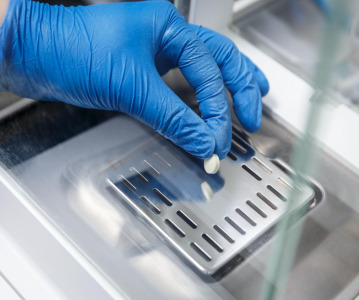Scientists make T cell discovery that could improve stem cell transplant process
A breakthrough on how T cells operate after stem cell transplants could lead to improvements in the process
Researchers have made a new discovery on how T cell receptors operate after stem cell transplants, shedding light on how the process might be improved.
Published in the journal Biology of Blood and Marrow Transplantation, the study explained how T cells divide into a number of clones with receptors in order to identify foreign bodies.
Effectively, this split in T cells leads to a range of receptor families known as either variable (V), diversity (D) or joining (J) segments.
Using a circular diagram to better visualise the arrangement of these different DNA segments, the researchers observed a similar fractal order in the T cell receptor of stem cell donors.
Dr Amir Toor, who led the study, discovered that this pattern was disrupted in patients who received a stem cell transplant, with all patients displaying a lower level of complexity in their T cell receptor repertoire at three months after transplant.
"Attempting to restore the fractal order of a patient's T cell receptor repertoire by optimising the stem cell transplant process could serve as a valuable therapeutic target," Dr Toor said.
The scientists intend to continue to use high throughput sequencing of patient's T cell receptors to learn more about how the immune system recovers after stem cell transplantation.
Related News
-
News Women in Pharma: Our hopes for 2025 and beyond
Our last instalment for 2024 of the Women in Pharma series brings you messages direct from the Informa Markets CPHI team as they discuss the advice and insights they have carried throughout their roles working at CPHI, and what they hope to see for the... -
News CPHI Milan 2024 - From the Floor
Milan and CPHI welcome you to 2024 CPHI Milan! As we celebrate the 35th edition of our flagship CPHI show, editors Vivian Xie and Lucy Chard bring you the latest from the show floor, conference sessions, and innovative solutions from all exhibitors, at... -
News The BIOSECURE Act: implications for the pharma supply chain
On September 9, 2024, the US House of Representatives voted to pass the bill titled the BIOSECURE Act (the Act), which lists several Chinese companies in the pharmaceutical supply chain. The Act will prohibit American companies from contracting or doin... -
News A Day in the Life of a Global CDMO Chapter Lead – Manufacturing
The 'Day in the Life of' series has covered many aspects of the pharmaceutical pipeline, including R&D and procurement, now we're taking a look at manufacturing from a global CDMO perspective. -
News CPHI Milan Speaker Spotlight: CDMO relations with Pharma and Start-Ups
In the run-up to CPHI Milan, we sit down with some of the experts and thought-leaders speaking at this year’s conferences. -
News Women in Pharma: Advocating for trans healthcare in pharma
In our monthly series on women in the pharmaceutical industry, we interview leading experts in the pharmaceutical supply and value chain to discuss the importance of gender diversity in healthcare, the workplace, and beyond. -
News Updated – Changing abortion pill access according to the US FDA and Supreme Court
After the approval of the medical abortion pill, mifepristone, by the US FDA, states across the USA approach the distribution of the pill differently, some ruling against allowing access to the drug. -
News CPHI North America 2024 – From the Floor
Welcome to Philly! CPHI North America once again graces the Philadelphia Convention Center, 7–9 May 2024.
Recently Visited
Position your company at the heart of the global Pharma industry with a CPHI Online membership
-
Your products and solutions visible to thousands of visitors within the largest Pharma marketplace
-
Generate high-quality, engaged leads for your business, all year round
-
Promote your business as the industry’s thought-leader by hosting your reports, brochures and videos within your profile
-
Your company’s profile boosted at all participating CPHI events
-
An easy-to-use platform with a detailed dashboard showing your leads and performance
.png)




.png)

